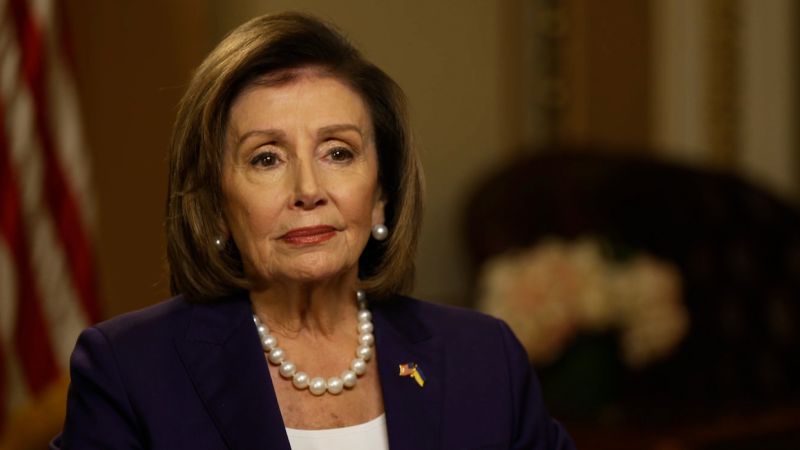The Washington Post Investigated House Speaker Nancy Pelosi’s Domestic Security after the Oct. 4th Domestic Violence Attack: A Warning to House Members and Members of the United States Capitol Police
Before the violent attack on her husband in late October, the security of House Speaker Nancy Pelosi’s California home had not been assessed by United States Capitol Police since 2018, Police Chief Thomas Manger told CNN’s Pamela Brown in an exclusive interview Tuesday.
The Washington Post first reported that the cameras installed by the U.S. Capitol Police were on when David DePape broke into the home through a rear door, but no one at the law enforcement’s command center in Washington, D.C., was watching when he entered.
House Speaker Nancy Pelosi revealed how she got the news that her husband, Paul, had been attacked, telling CNN’s Anderson Cooper that she was “very scared” when there was a knock on the door from Capitol Police.
The San Francisco Police Department leads the investigation but a task force was formed after the attack, which involved the Federal Bureau of Investigation. On Tuesday Tom Manger, the USCP chief , released a statement saying the attack on Mr. Pelosi was ” an alarming reminder of the dangerous threats elected officials and public figures face during today’s contentious political climate.”
Wednesday’s statement acknowledges that additional resources were earmarked to upgrade security systems after the January 6 attack. “Now we will fast-track the work we have already been doing to enhance the protection of Members outside of Washington, D.C., while also providing new protective options that will address concerns following Friday’s targeted attack.”
Security measures at their homes and their offices were boosted by lawmakers after a significant increase in threats.
The statement praised he work of the members of the agency and added what appeared to be a warning: “a significant change that will have an immediate impact will be for people across our country to lower the temperature on political rhetoric before it’s too late.”
Following last week’s attack, the head of House sent out a memo urging all staff and members to use the resources available to them to protect themselves.
Paul’s doorbell rang, but she didn’t know he was there, or what happened to Giffords and Scalise
In her first interview after the attack, Pelosi said that she had been asleep in DC after returning from San Francisco and that her doorbell rang early in the morning. I can see that it is 5. [a.m. ET], they must be at the wrong apartment,” she told Cooper after he asked where she was when she got the news.
“And I’m thinking my children, my grandchildren. I never thought it would be Paul, I knew he wouldn’t be out and about. They came in. She said that at that time they didn’t know where he was.
The members of Congress have faced threats and violence before. Democratic then-Rep. Gabby Giffords of Arizona was almost killed after being shot in the head in 2011 and Republican Rep. Steve Scalise of Louisiana was shot and wounded during practice for a congressional charity baseball game in 2017. Increasing threats have been received by politicians from both parties.
A man is charged with threatening a family member of a public official and other crimes. He did not plead guilty to the state charges.
Pelosi and the Capitol Police: The State of the State, the FBI, and the Department of Homeland Security and the 2019 Capitol Police Outreaction
Pelosi, one of the most powerful figures in national Democratic politics, has earned a reputation as a formidable leader to House Democrats who exerts significant influence on her caucus. But speculation is intensifying in Washington over what Pelosi’s next move will be, and whether she would decide to retire, if Republicans win back the majority.
The speaker said the “decision will be affected about what happened the last week or two,” prompting Cooper to ask, “Will your decision be impacted by the attack in any way?”
In a November letter exclusively obtained by CNN, Democratic Rep. Zoe Lofgren of California, the chair of the House Administration Committee, asked the USCP for detailed answers about the lack of security at the Pelosis’ home, including why the residence had not received an assessment in the previous four years.
“Anytime there’s a change in leadership position, we will do an updated assessment,” Manger said, noting that members can also request the security assessments.
Pelosi communications director Henry Connelly told CNN her office would not discuss security matters in response to questions about whether she had previously requested those assessments.
In 2021, Pelosi was the subject of 632 threat cases opened by the USCP, according to Lofgren’s letter, more than 6% of all threat cases overseen by Capitol Police last year. The Justice Department received at least 24 of those threats, according to the letter.
The USCP needs to increase their security posture for whoever is the speaker of the House and anyone who has received threats.
“The level of violence in our country directed toward political officials, government officials, it’s really at a point where I think that it’s as dangerous as it’s ever been to be an elected official,” Manger said, noting the number of threats has only increased since his appointment in July 2021.
The Capitol Police has worked to fill hundreds of job vacancies, hiring 280 officers this year, and has also contracted 40 to 50 unarmed guards who check security badges and credentials for individuals already inside the Capitol.
“It’s just the sheer volume of what we’re dealing with now versus what we dealt with years ago,” Manger said. I am not sure that the Capitol Police would be able to keep that from happening. We have to deal with the growing number.
